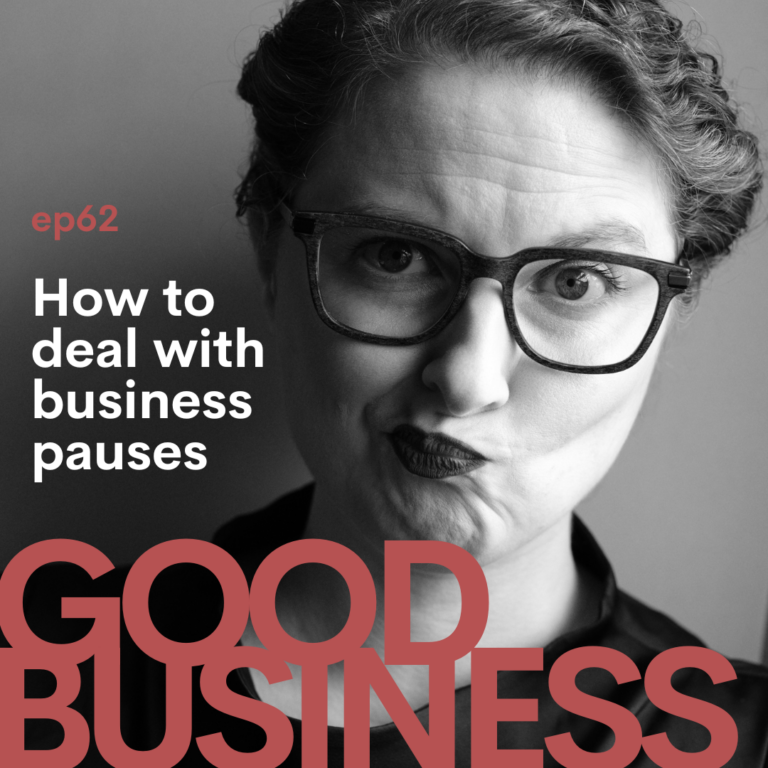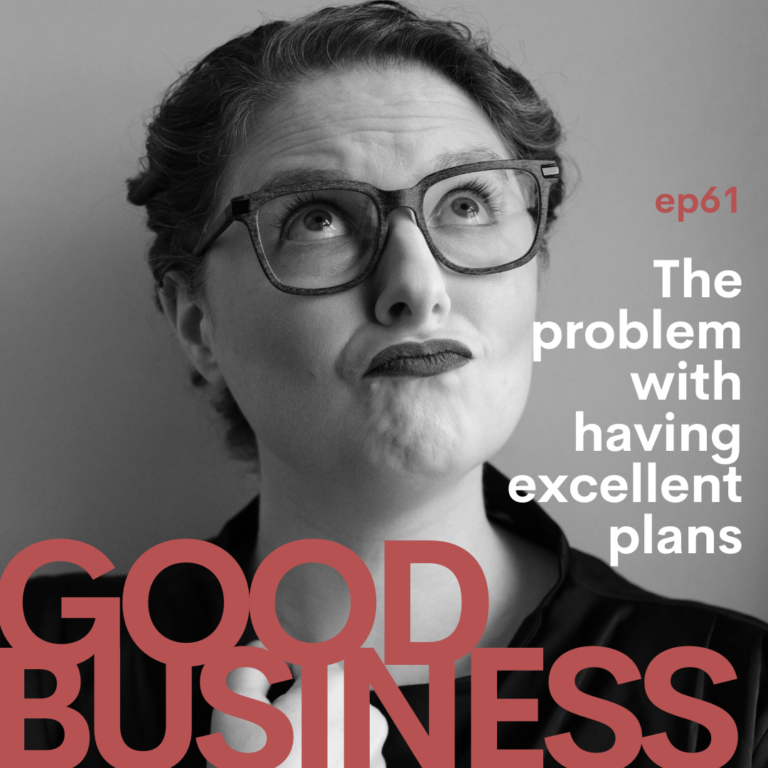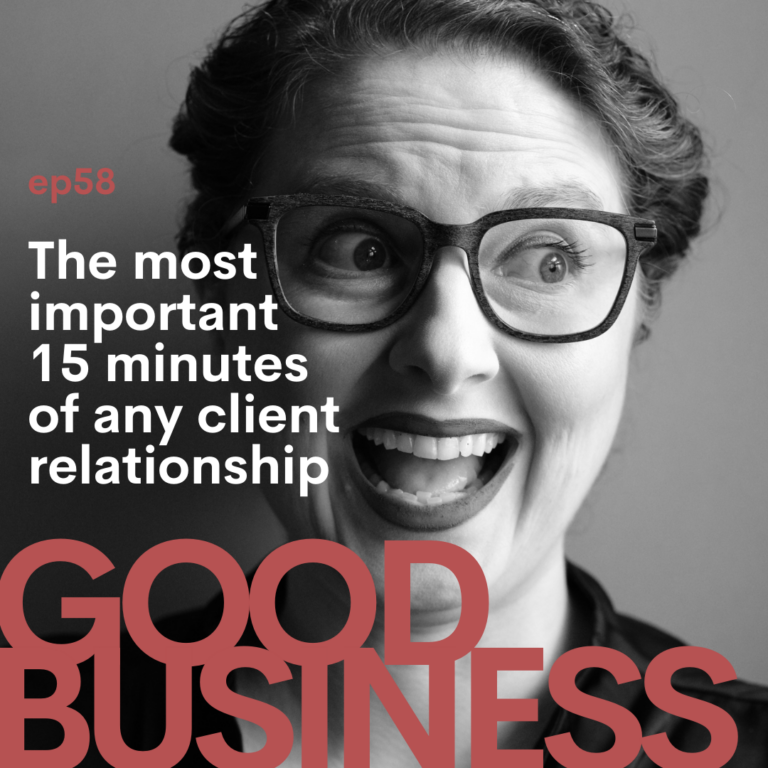Episode Transcript:
Welcome to another episode of The Good Business Podcast. I’m your host Illana Burk. And today is our second in a several part series on offer design. On our previous episode, we talked about knowing what your promise is and keeping it. And today we’re talking about how designing the schedule of your offer and your own schedule aligned with that is the first steps in really leading well in any offer design.
When you think about how to create an offer for anything, product service, whatever, oftentimes we think about what do we have to sell and what does the market expect me to do in order to sell it? To pull our same examples all the way through this whole series, on our first episode, we talked about a jewelry designer, and then we also talked about maybe coaching. Maybe web design. So those are going to be the three examples we’ll pull through, because I think they, they hit a lot of market areas of similarity. Let’s say you’re a jewelry designer and you think about how you offer what you offer based on what everybody else is doing. That’s what most people do when you create a new thing, you go to sell it and you look around and see what everybody else is doing and you sell that way. But recently I’ve been seeing some really interesting things happening, specifically the jewelry market, which I think is a really good example of the simple idea that designing around your own flow and your own schedule is how you create a freedom-based life that you can actually be excited about. And you do it right from the start rather than going five years from now, when I’m successful, then I’ll change everything up and have a reasonable schedule, and I won’t hustle so much. So the couple of things that we’re talking about here is your own working schedule, and then also how you deliver on your promises, what you actually give to your clients and how you sell it.
What I was about to say was in the jewelry market, it’s pretty straightforward. Most people are like, I make earrings. I will put up an Etsy store or maybe a Shopify store, and then I’ll start selling my earrings. But what I’m seeing more and more with the advent of Instagram and people really developing followings through social media and TikTok and behind the scenes looks at things, they’re not doing traditional stores where things are for sale all the time. Instead, they’re doing big product drops, where they generate a bunch of interests, they show a little sneak peaks throughout the quarter or the year, depending on how often they do it. And then they drop a whole bunch of products all at once. So they build a whole bunch of momentum and then a whole bunch of selling all at once. So that means that the entire rest of the time they get to focus on being creative. They get to use their time the way they want, because they’re not constantly switching between being a creative and being a shipper or a packer or a business owner or a marketer. They get to just focus on doing really amazing work, which in most of these instances is going to really feed into keeping that original promise.
So what’s important to note with this example, is that they’ve designed both the delivery system and their own personal workflow around the way in which they can keep their promises best. They want to create something unique. They want to create something. That’s an event. They want to create something that’s one of a kind. All of that feeds nicely into the idea of I’m going to build momentum and then I’m going to sell all at once. So for a few days a year, I focus on selling. The rest of the time, I get to be a jewelry designer, continuing to hone my craft.
This is a way… it’s a really good example of showing how you can take a really straightforward transactional business model and turn it into something that is really different and really works for you. It’s also positioning you well as a leader. It’s creating some legitimate scarcity, which are all trigger things when they’re used to manipulate. But in this instance, when you create a bunch of one of a kind things creating a special experience where people get to be in on something, it’s not a bad thing. There’s no manipulation there. It’s simply, I only have one of this thing. If you really, really want it, you’re going to have to show up because there’s a lot of people interested in that. So you’re creating buzz and it’s all happening really organically.
Let’s use a different example around scheduling. Let’s say that you’re a new coach and you’re trying to figure out. How often your calls with clients should be. You’re trying to figure out how often you should work. You’re trying to figure out how to squeeze those two things together. And you’re trying to figure out how to say yes to absolutely every opportunity that comes along because you’re hungry. Right? You’re new. You’re hungry. You don’t want to say no to anybody. And most of us are under the dramatic misconception that more availability equals more clients because it allows you to open up more time. That’s simply not true. There’s almost 7 billion people in this world. There’s plenty of clients. Having more availability and trying to make yourself available to absolutely everyone, no matter whether it’s a productive time of the day or a convenient time of the day for you or not, it’s going to result in just one thing and that’s burnout. Happens again and again and again.
So I did this exercise with clients. Now this can basically be applied to any service-based business as well. I do an exercise with new clients when they’re starting new businesses. And I ask them about what they want their business to look like, what they want their day to look like, what they want their business flow to look like five years out.
And it usually looks something like I work a few days a week. I have a really manageable schedule. I talk to a couple of clients a day. I am valued for my work and my time.
And then I ask them what they are thinking for their offer design now. And they’re like, well, I can take a maximum of six clients a day and I can work between the hours of 6:00 AM and 10:00 PM so that I can hit everybody in every time zone.
And I go, so how are you going to get out of that and into that five-year from now version? And they kind of look at me with that deer in headlights look like, oh my God, I hadn’t thought of that. So instead, come at it from a leadership standpoint. How are you at your best? Because I promise you, you cannot keep your promises if you are not a morning person and you take a 6:00 AM call with someone on the other side of the world who’s at 4:00 PM and bright eyed, bushy tailed, and ready to go. And you are barely conscious and trying your best to be your best at a moment in time that you cannot be your best.
A lot of things are happening there. First, you are not listening to your body. You’re not listening to your own circadian rhythms. You are not listening to that little voice in your head going, I am not a morning person. I cannot function at that time of day.
You were also allowing the client to lead. And that’s a far more dangerous one because a lot of us can rally even when we’re not at our most productive and we can deliver on our promises, even when we’re not at our very best. It’s not advisable, but a lot of times we can not sustainably, but for a while, at least. But what you can’t do is allow your client to lead and expect them to follow you when you’ve just said, Hey, I know this is an insane and inconvenient time for me, but I’m totally willing to do it because it’s more convenient for you.
That’s what you can’t do, because what you’ve told them subtly in that message is, I am willing to bend over backwards and do absolutely anything to keep you happy. That is doing nothing good for anyone. Because they hire you, for your big shoulders, they hire you, no matter what it is that you’re selling, they hired you to be the expert. That means they hired you to lead them.
If the very first thing you do is the other way around. You will never be able to get the reins back. They will never fully respect and listen to you because you didn’t draw good boundaries around what you actually need to function at your best. Trust me, they would rather have your best at a time it’s inconvenient for them than to have your mediocre at a time that is convenient for them. You’re better off saying no to a client than you are at saying yes at a time where you can’t deliver on your promises. So always think about that.
Likewise, if you only want to work four days a week, five years from now, that means you actually only want to work four days a week now. So block off a day of the week. Build your pricing models around your scheduling needs so that you can always be sure you’re delivering on your promises. Scheduling and promise keeping are two halves of the same coin. It’s not a small thing. And I promise you, thanks to this incredible global economy we have, if your most productive time is at two o’clock in the morning, and that’s when you want to offer coaching slots, you’re going to find people at a time zone that that works beautifully for. You have a lot more options than you ever did before. You don’t have to hit your time zone. You don’t even have to hit other people’s times zones. Do you have to hit a time zone that aligns well with who you want to serve. And I promise you, there’s a sweet spot out there.
Don’t let time zones and the convenience of other people guide your business choices. It’s the last thing that you should use to consider? The first thing is what do I need to deliver on my promises? How do I deliver them best? How much time do I need to deliver them?
How much time do I spend on the phone with them? How many times do I want to talk to them? What do I need to keep my promises? It’s the most important question you should be asking at every stage of offer design. What do I need to do to keep my promises in the best way possible, so that I have a marginally inconvenienced client who’s over the moon with what I delivered?
They’re going to be way happier with you overall. I promise. And those little timing inconveniences will be a blip on the radar. If you are leaving them with the impact that they signed up for and paid for, they’re going to be delighted with whatever you deliver at whatever time of day it is. All right, everybody. We’ll see you very soon.
Our next podcast episode is going to be on delivery on your terms. So we’re going to talk about tools, technology, and how to lead and nudge your clients into things that they might not be necessarily prepared for so that you’re not making assumptions about what they can and can’t do.
This will be a really excellent episode for those of you who have technophobic clients or clients who you struggle with getting them into the things that you think will make you most effective. So I look forward to seeing you all then. Bye.
More Episodes
How to deal with business pauses | GB62
In the fast-paced world of entrepreneurship, taking a break can often feel like a foreign concept. The constant pressure to grow, scale, and make a bigger impact can make prioritizing personal well-being and life outside of work...
The problem with most excellent plans | GB61
Ever plan an amazing business move but hit a roadblock? This episode tackles the "pothole" of poor planning for solopreneurs. Learn how to "right-size" your strategy based on your resources and set yourself up for sustainable...
When to stick and when to bail | GB60
Feeling stuck in a business project that’s not taking off? This episode’s for you! We explore the often-overlooked skill of quitting and guide you through 4 key questions to help you decide when to persevere or let go. Learn to identify your true motivations, navigate self-doubt, and make choices that align with your goals and well-being. Listen to discover when to stick and when to bail!
You might not need a VA after all | GB59
Overwhelmed business owner? Stop! Hiring a VA might not be the answer. Learn how to ID expert vs. VA tasks & hire the right person for the job (without becoming a “shitty boss”). Listen in and get bonus tips in the show notes!
The most important 15 minutes of any client relationship | GB58
In this episode of the Good Business Podcast, we dive into the critical 15 minutes that can make or break a client relationship. Want to know why these first few minutes are so crucial, what should be included, and how to adjust...
Want better clients? Make more mistakes. | GB57
Today’s topic is mistakes in business. Why? We all make them. Good business involves managing both good and bad situations effectively, with elegance, education, confidence. This skill is often overlooked. Let’s explore common...






